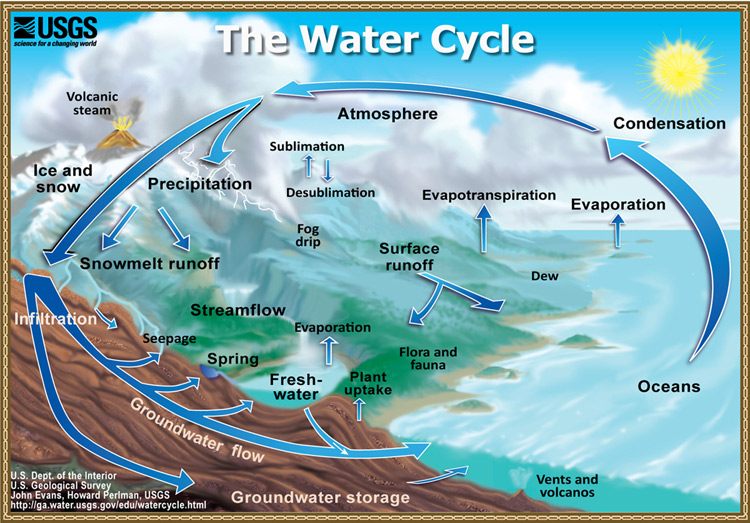
Source: USGS
Climate is all about where the water started, where it goes and when it does it. This is what leads to regular, moderate weather. It is also what leads to droughts and floods. This is how we end up with deserts in one place and tropical rainforests in another and grasslands in yet another. So, if you change the climate, you change the way the water is being redistributed. This is going to lead to changes that are quite likely to unpleasant. Rich farmland becomes dried up. Populations of people experience water shortages. Grasslands get more rain and experience invasive species growth and soil erosion. And, then when rain does come in the parched regions, it frequently comes in enormous amounts. Australia experienced flooding in 2010 and 2011 that was so massive it actually lowered the world's sea levels when the water got trapped in the interior of the continent.
All of this will cause economic turmoil and result in higher prices for the average person. Take a look at the current drought in California as an example. Now, it is debated about what role climate change has in this current drought. We'll get back to that point, but right now we want to look at the cost to the average American as a result of this drought.
This current drought is turning out to be the worst drought in the history of the state and may continue for years, or even decades. It is certainly going to result in changes to the way things are done. Look at this graphic from the U.S. Drought Monitor to see the extent and severity of the drought.
 |
| Source: U.S. Drought Monitor |
News reports show that as many as 17 California communities have less than 100 days of drinking water left. The snowpack, which delivers a third of California's water, is at only 20% normal. Farmers are ripping out crops because of a lack of water. Reservoirs are at near record low levels.

Source: Motley Fool
This is going to lead to higher prices for food and some products for the average customer. Higher expenses are always passed on to the consumer at the bottom and scarcity in products always leads to higher prices for those products. Just plain, simple supply and demand, except this time we're talking about food.
Many people would argue that the water problems facing California are self-inflicted, and I support that position. The population has exploded in the state and increased the water demand, but water management policies have been horrible, even as the state has been warned on a continuous basis that this day would eventually come. However, the drought is caused by a lack of rain and that lack is not the result of any policy hatched in Sacramento.
The question that climate change has in this continuing drought is hotly debated. Some point out that it is a lack of rain that has caused the drought, not higher temperatures. Others point out that this drought is very similar to one California experienced in the 1970s. It is also pointed out that some climate change models predict California will get wetter, not drier.
I believe the drought is a naturally occurring event that would, eventually, have occurred with, or without, global warming. But, I also believe the severity is affected by climate change. The same currents in the jet stream that have caused the polar vortex blasts of cold air and severe winter for the middle and eastern parts of the country are also responsible for keeping Pacific storms from coming ashore in California. I believe the evidence is that these currents have been made more severe due to global warming.
But, as I said, that is something that is being debated. The important point for us to learn from this drought is that water management is vital to our well-being and this management is not going well, with global repercussions.
Consider this, from Motley Fool:
Most people view water as an infinite, inexhaustible resource, much like air. After all, it's part of a whole natural cycle, right? For most practical purposes, though, water -- especially clean, safe drinking water -- is resolutely finite and exhaustible. It's getting worse as the global population hurtles toward the 9-billion mark, as agricultural and fuel extraction guzzle more and more water, and as climate change adds growing stress to existing supplies.Source: Motley Fool
Consider a few alarming indicators:
- One in seven people around the world lack access to safe drinking water.
- The Global Economic Forum identifies water crises as the third most serious risk the world faces in 2014.
- The poorest 20% of households in El Salvador, Jamaica, and Nicaragua spend up to 10% of their income on water.
- From 2003 to 2010, parts of Turkey, Syria, Iraq, and Iran lost 144 cubic kilometers of stored freshwater -- about the same amount of water as there is in the Dead Sea. Many scholars draw a solid line between water scarcity and the recent conflicts in those regions, and the U.S. director of national intelligence sees global water overuse as a potential threat to national security.
- NASA data from Jan. 17 showed California's backup groundwater reserves to be so depleted that the losses could be detected from satellites 400 kilometers above the earth's surface.
Water management, or the lack of good management, is leading to world crisis and food shortages. That is not anything that is in doubt. And, historically, this has always been true, even before there was any climate change.
So, as the debate goes on about the role climate change has with the redistribution of water around the globe, things continue to get worse. Now, let me ask you a question:
Are you willing to bet your safety and your pocketbook that climate change has no role in any of this?
No comments:
Post a Comment